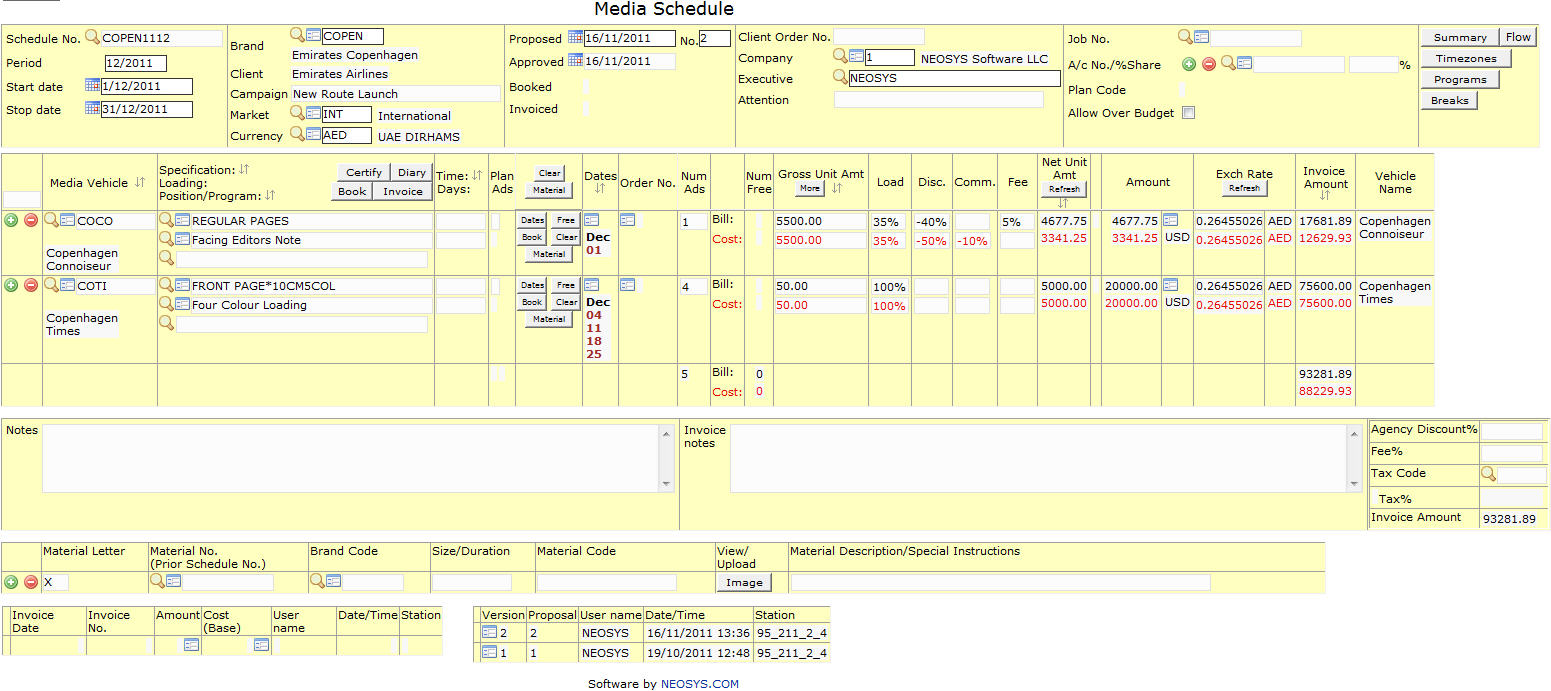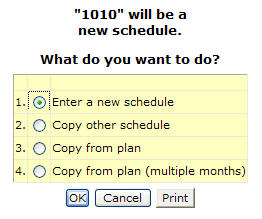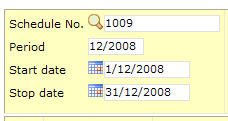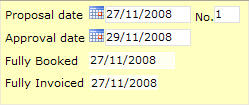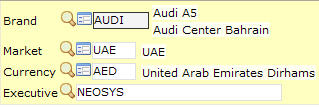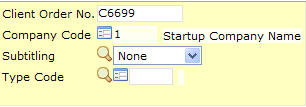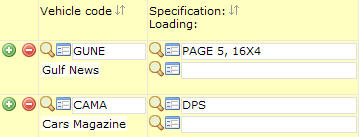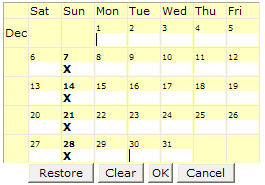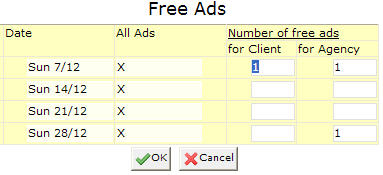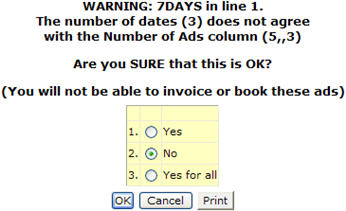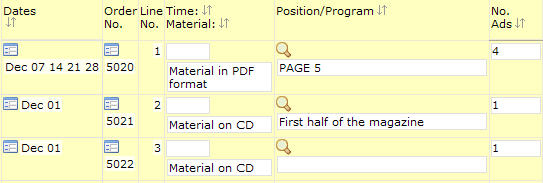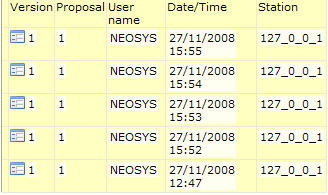Schedule file: Difference between revisions
m (63 revisions) |
|||
| Line 200: | Line 200: | ||
===== Dates ===== | ===== Dates ===== | ||
Shows all the dates the ads have been scheduled for which were selected in the Dates calendar. Clicking on the icon in the Dates column gives you an overview of the ads specific to that line in a media diary format. | Shows all the dates the ads have been scheduled for which were selected in the Dates calendar. Clicking on the icon in the Dates column gives you an overview of the ads specific to that line in a media diary format.. | ||
===== Order No. ===== | ===== Order No. ===== | ||
Revision as of 08:47, 23 September 2008
Schedule no.
Shows the schedule number. You can either open an existing schedule by entering the schedule number or create a new schedule. The schedule number can either be generated automatically or manually entered. As you press ‘enter’ on the blank field a popup will give you the option of creating a new schedule or copying data either from an existing schedule or plan onto a new schedule.
When opening an existing schedule you can directly enter the schedule number manually or press F7 and search for the schedule as per Brand, Period or Executive.
Period
This automatically shows the current month and year which can be changed if required.
Start date & Stop date
As the name suggests these fields show the start and the end date of the advertising campaign. You can book for a maximum of upto 35 days at a stretch and select the dates accordingly here. The system does not allow you to go ahead with the schedule if the gap between the Start and Stop date is beyond 35 days.
Proposal date
Shows the date the ad campaign was proposed which by default shows the current date and can be changed if required.
Proposal number
Proposals are user controlled versions. You may send revised proposals to the client and NEOSYS allows you to keep track of all the proposals generated by saving them as proposal numbers. The first time a schedule is saved it is by default saved as proposal number 1, After that each time a schedule is saved you have the option of updating the schedule to a new proposal number and hence keep an audit trail of all changes made to the schedule.
Approval date
Shows the date the campaign is approved by the client. You can press F7 and select the date. A schedule has to be approved in order for it to be booked so if an unapproved schedule is being booked the system marks it as approved and the approval date is updated automatically with the current date.
Fully booked & Fully invoiced
Shows the dates the schedule is fully booked and invoiced. The dates cannot be manually entered on these fields, they are updated automatically when the schedule is booked and invoiced.
Brand
Allows you to enter the brand code of the product being advertised.
Market
Allows you to enter the market in which the product is to be advertised. The system alerts you when you select a media vehicle which is not in the target market.
Currency
The currency on this field is the currency the client is to be invoiced in. This field is updated automatically with the invoice currency mentioned in the client record in the Client and brand file and if no currency is mentioned in the client record it is updated automatically with the base currency.
Executive
Shows the executive name as entered in the client and brand record of the selected brand. If no executive name is entered in the client and brand record this is updated with the current user's User code as entered in the User details page in NEOSYS. This can be changed if required.
Client Order No.
Shows the client order number, if any. This has to be entered manually and is mostly used for agency reference, this appears on the schedule and invoice printout.
Company Code
Allows you to enter the code of the company you represent. Incase of a single company this is updated automatically and if there are multiple companies it has to be entered manually.
Subtitling
Allows you to subtitle the schedule lines on the schedule in the following orders:
- None
- Media Type
- Market
- Supplier
- Currency
Type Code
Allows you to enter the type of media used for advertising.
Vehicle code
Codes are short abbreviations given to records under various files in the NEOSYS database. Codes are easier to remember and information pertaining to a particular record can be pulled up by entering its code. It cannot be more than 8 alphanumeric characters.
NEOSYS advises users to use the 4 letter coding system in order to ease the complex task of assigning different codes to various records. See Codes in NEOSYS.
Allows you to enter the media vehicle code. Every vehicle record shows its specified market and if the market of the entered vehicle does not match the market chosen in the media schedule the system prompts the user about the same, this helps in avoiding scheduling mistakes.
Specifications
Allows you to enter the specifications of the scheduled ad.
Specifications are special or fixed positions in a media vehicle. The rate card specifies the charge for advertising on these specific positions on the magazine or newspaper. NEOSYS allows you to enter these special positions in the vehicle rate card record with their respective charges conveniently.
Below is an example of how specifications appear on the rate card of a magazine
Special Positions US$
Outside back cover 8,000
Inside front cover 7,500
Page one 7,500
Inside back cover 7,500
Double page spread 7,900
Loading
Allows you to enter the loading details of the scheduld ad.
Loading charges are like the add ons over the cost of the ad. For instance you may want a full page ad but there maybe extra charges depending on where the ad is be placed within a newspaper or a magazine, for eg. the first half of a magazine is more expensive than the second half, these extra charges are called loading charges. They are usually a particular percentage of the cost of the ad which can be viewed on the rate card.
Below is an example of loading charges in a magazine rate card -
For specified position/facing matter 10%
First double page spread 25%
First third of magazine 25%
First half of magazine 20%
The Specification and Loading fields are directly linked to the rate cards. Assuming the rate cards have been entered in NEOSYS, the cost of the ad and the loading charges are automatically calculated by the system based on the size of the ad which is then entered in the bill and cost section.
Dates
Allows you to select the scheduled dates of the ads. The number of ads or a material letter(A,B,X,1,3,etc.) can be used to mark the dates and once you press OK you wil get a popup confirming the number of dates chosen.
Only those days of the week can be chosen which have been selected in the vehicle record. If unable to select a particular day in Dates please select that day in the Day of week section in the vehicle record.
If the user selects a date for a brand with a vehicle with which it has already been scheduled the system prompts the user about the same. This helps in avoiding creation of unneccesary excessive schedules.
The following options can be used to enter the ads as required -
X - Indicates a single ad
2 - Indicates two ads (of type X)
A - Indicates a single ad using material "A"
B - Indicates a single ad using material "B"
2A - Indicates two ads of material "A"
ABC - Indicates three ads of different types A, B and C
3A2B - Indicates five ads, 3xA and 2xB
Free
An ad or ads could be free of cost either to the agency or the client or to both, NEOSYS allows you to choose all options and the system automatically makes the changes in the bill and cost section based on the number of free ads to the client or to the agency.
Certify/Certification file
Book
Allows you to issue booking orders to the supplier. Clicking here opens the Media booking order form where the booking details have to be entered as required and a preview of the booking order can be viewed before issuing the final order.
See New Booking Orders/Cancellations
Diary
Allows you to view the schedule information in a media diary format. The information on this diary is specific to the schedule.
See Media Diary
Invoice
Allows you to issue invoices to the client. Clicking on the invoice button opens the New media invoice page where changes can be made as required and the proforma invoice can be viewed before creating the invoice.
NEOSYS recommends to always check the proforma invoice before invoicing the client in order to avoid mistakes on the original invoice.
Appearance details
Dates
Shows all the dates the ads have been scheduled for which were selected in the Dates calendar. Clicking on the icon in the Dates column gives you an overview of the ads specific to that line in a media diary format..
Order No.
Shows the order numbers of all the booking orders generated so far which can be viewed by clicking on the icons on this column.
Line no.
Shows the line number which is in order of time of creation regardless of where it appears on the schedule. The line created first is no.1 and the one after that is no.2 and so on.
Time
Allows you to enter the time of the ad. This is mainly used for TV advertising, showing the time the advertisement is scheduled to take place. Incase of multiple ads you can enter the time separated by commas.eg, 10:12, 14:20:10, 18:44. You can choose whether the Time can appear on the printouts or not on the printout formatting page. This appears on the details column of the printout.
Material
Allows you to enter reference data regarding the materials sent to the supplier. This data appears in the details column of the printouts which can be selected to appear or not.
Position/Program
Shows the position or program of the ads in case of newspaper and television or radio ads respectively. This information also appears on the details column of the printout if selected to appear.
No. Ads
Shows the number of ads entered in the Dates calendar on the schedule line. If the number of ads on this field are changed for some reason the system will warn you that the number of ads in the Dates calendar do not match the number in the Number of Ads column and confirm with you whether its ok before saving the schedule. It also warns you that you will be unable to invoice or book these ads due to this difference.
Bill and Cost Section
The bill and cost section is a vital aspect of the media schedule. All the details about the cost to the agency and client, discounts received and given, commission, etc. are entered in the bill and cost section.
If the vehicle currency is different from the invoice currency, the system calculates the invoice amount based on the exchange rate entered in NEOSYS.
When the cost to the agency is more than the cost to the client the system prompts the user about the same and once that is confirmed a reason for the unporofitability has to be mentioned. The system prompts the user also when the cost to the client is over 50% than the cost to the agency. This feature is helpful in avoiding entering of incorrect amounts in the schedule.
NOTE – currency exchange rates have to be entered in NEOSYS as and when required.
Notes
Allows you to enter notes which could be any reference information regarding the schedule. If there are notes on the vehicle record of the selected vehicle, you are given the option of adding those notes to this section as you enter the vehicle code. These notes appear only on the schedule printouts.
Invoice Notes
Allows you to enter notes regarding the invoicing which appears on all invoices issued from the schedule.
Additional discounts and charges on Invoice
Agency Discount/Fee/Tax
Allows you to enter the percentage of discounts and charges on the bill to the client which is over and above the costs entered in the Bill row.
Material Details
Allows you to enter the material/artwork details which can be selected to appear on the schedule and invoice printouts. You can also upload images on the schedule with reference to the artwork.
Material Letter
Automatically shows the material letter used in the Dates calendar of the schedule.
Prior Schedule
Allows you to select another schedule number with similar material specifications which is useful for reference purposes.
Brand Code
Shows the code of the scheduled brand. The brand name shows automatically in the material description field which can be edited if required.
Size/Duration
Allows you to enter the size or duration of the ads incase of newspaper and television or radio ads respectively.
Material Description/Special Instructions
Allows you to add the material description and special instructions to be followed by the supplier.
List of invoices issued
Shows a list of the invoices issued from the schedule with the invoice details.
Invoice date
Shows the date the invoice was created.
Invoice No.
Shows the invoice number.
Amount
Shows the invoice amount. You can view the issued client invoice by clicking on the icon on this column.
Cost(Base)
This amount always shows in the base currency regardless of the invoice currency. You can view the cost invoice by clicking on the icon on this column.
User Name
Shows who created the invoice.
Date/Time
Shows when the invoice was created.
Station
Shows the IP address of the computer used to create the invoice.
List of Proformas
Shows the issue date and number of only those proformas that have been saved. Proformas can be saved on an invoice by invoice basis before issuing the invoice.
Version section
What is a version?
NEOSYS document versioning provides a complete verifiable audit trail of who has done what, where and when in NEOSYS. There is no user interface to amend these records and versions are numbered sequentially to make it harder to tamper with.
Every time anyone creates or updates a record in NEOSYS, NEOSYS records their username, the time and date, the workstation number. It also keeps a copy of the old record.
At the bottom of each record on screen, you can see a complete history of creation and all amendments and you can click on any individual amendment to see the prior record.
If the same user makes more than one change to a particular record in one day then only one historical version will be retained for reference but the date, time and workstation number of all updates is records. This is to save wasting space in the database.
How do I save a schedule as a different version?
Each time a schedule is saved you are given the option of updating to a proposal number. If you go ahead with updating to a new proposal number automatically a new version number is created.
Version
Shows the version number and number of times changes have been made to the document.
Proposal
Shows the number of times the document has been updated to a proposal number.
User name
Shows who made the changes to the document.
Date/Time
Shows when the changes were made.
Station
Shows the IP address of the computer used to make the changes.
